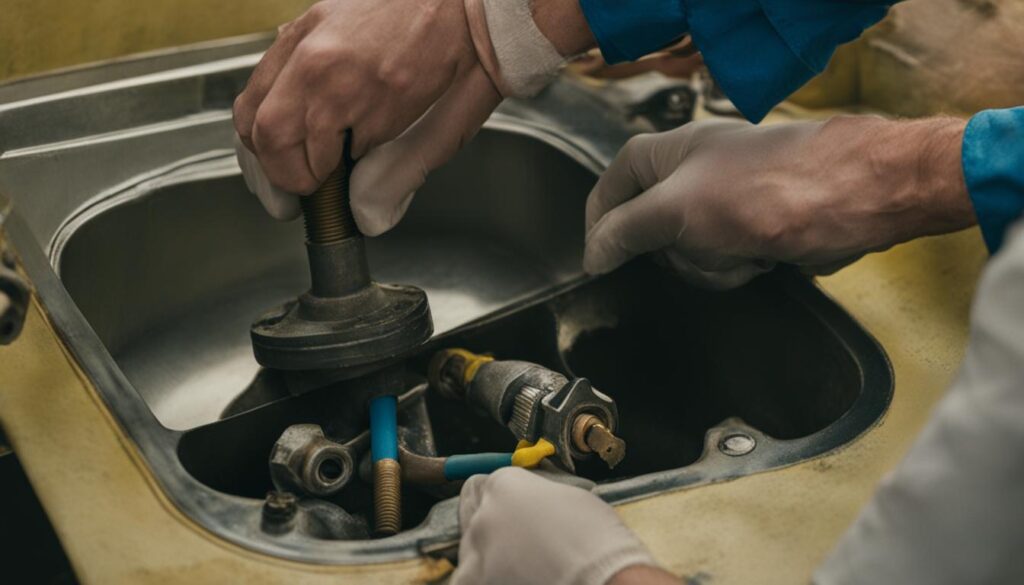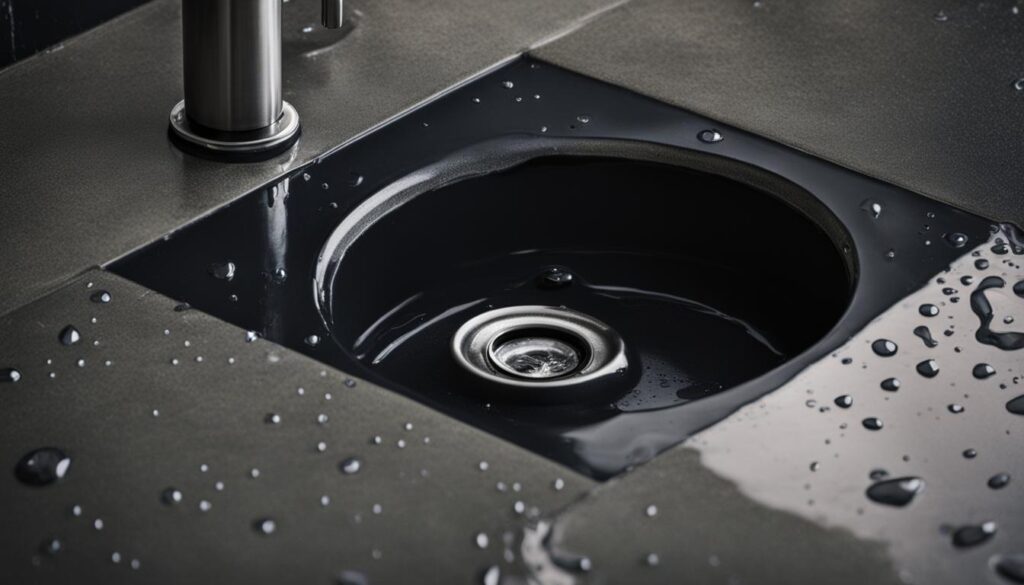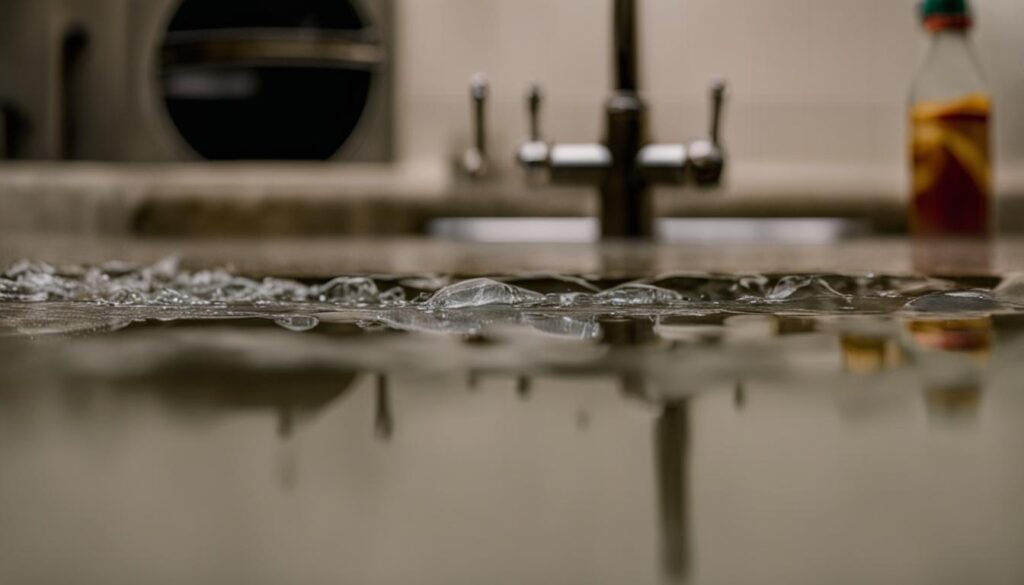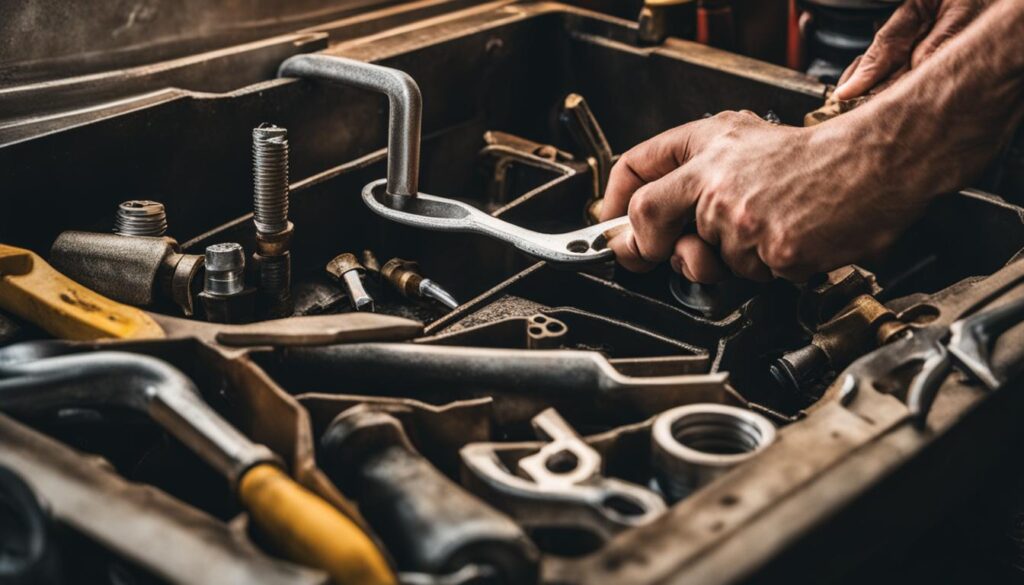A leaking garbage disposal can be a frustrating and messy problem to deal with in your kitchen. The good news is that you can often fix the issue yourself, saving time and money. In this guide, we’ll walk you through the simple steps on how to fix a leaky garbage disposal effortlessly.
There are two common causes of leaks in a garbage disposal: a worn rubber gasket on the top and a loose or deteriorated flange. By identifying the cause of the leak, you can easily determine the course of action to fix it.
Key Takeaways
- Identify the cause of the leak: worn gasket or faulty flange.
- To fix a gasket leak, disconnect the drain, unplug the disposal, remove the old gasket, and replace it with a new one.
- If the flange is responsible for the leak, detach the disposal, clean off the old putty or flange, and reseal it with a new flange or fresh plumber’s putty.
- Troubleshoot leaking by filling the sink with dyed water and inspecting the disposal for colored water.
- Consider DIY repair or professional replacement, depending on the severity of the leak and your plumbing skills.
Replacing a Leaking Garbage Disposal Gasket
If you’ve noticed a leak coming from your garbage disposal, one of the most common causes is a worn rubber gasket on the top. Fortunately, replacing this gasket is a straightforward process that you can do yourself. Here are the steps to repair a leaky garbage disposal by replacing the gasket:
- Start by disconnecting the drain and unplugging the disposal to ensure your safety.
- Next, use a wrench to twist off the mounting nut and carefully remove the disposal.
- Peel off the old gasket, making sure to remove any residue.
- Now, take a new gasket and position it in place, ensuring that it sits flat.
- Reassemble the disposal by following the reverse order of the disassembly.
- Finally, test the disposal for any leaks by running water and checking for any signs of water dripping.
This simple repair should effectively fix the leak in your garbage disposal. By replacing the gasket, you can prevent any further water damage and ensure the proper functioning of your disposal.

Remember, if you’re unsure about any step or encounter any difficulties during the repair process, it’s always recommended to consult a professional plumber to avoid any potential mishaps.
Resealing a Leaking Garbage Disposal Flange
If you have a leaking garbage disposal and the source is identified as a faulty flange, don’t worry! With a few simple steps, you can reseal the flange and put an end to the leak. Follow the instructions below to stop the leak in your garbage disposal.
Disconnecting the Drain and Unplugging the Disposal
Before you begin, it’s important to ensure your safety by turning off the power to the garbage disposal. Locate the circuit breaker that controls the disposal and switch it off. Then, disconnect the drain pipe from the disposal by loosening the slip nuts with a pair of pliers. Once the drain pipe is detached, unplug the disposal from the electrical outlet.
Removing the Mounting Nut and Dropping the Disposal
Next, use a wrench to twist off the mounting nut that holds the disposal in place. Once the mounting nut is removed, carefully drop the disposal down from the sink. Be cautious and avoid damaging any pipes or connections.
| Step | Description |
|---|---|
| 1 | Disconnect drain and unplug the disposal |
| 2 | Remove the mounting nut and drop the disposal down |
| 3 | Loosen the bolts and remove the clip holding the bottom flange |
| 4 | Clean the area and apply fresh plumber’s putty |
| 5 | Reinstall the flange and tighten the screws |
| 6 | Reconnect the disposal and test for leaks |
Table: Steps to reseal a leaking garbage disposal flange
Loosening the Bolts and Removing the Clip Holding the Bottom Flange
After the disposal is dropped down, locate the bolts that secure the flange and loosen them. Once the bolts are loosened, remove the clip that holds the bottom flange in place. Take caution not to damage any surrounding parts or pipes during this step.
Cleaning the Area and Applying Fresh Plumber’s Putty
With the flange detached, thoroughly clean the area around the flange and the sink surface. Remove any old putty or flange residue. Once the area is clean, apply fresh plumber’s putty to the flange. The putty will create a watertight seal between the flange and the sink.
Reinstalling the Flange and Testing for Leaks
After applying the plumber’s putty, carefully reinstall the flange by aligning it with the sink opening. Once the flange is in place, tighten the screws to secure it. Finally, reconnect the disposal to the electrical outlet and the drain pipe. With everything reconnected, test the garbage disposal for leaks by running water and checking for any signs of water escaping.
By following these steps, you can successfully reseal a leaking garbage disposal flange. This simple repair can save you time and money, ensuring your kitchen remains clean and leak-free.

Troubleshooting Leaking Garbage Disposal
If you are dealing with a leaking garbage disposal, it’s important to troubleshoot the issue before deciding on the best course of action. By identifying the source of the leak, you can determine whether a DIY repair is sufficient or if a replacement is necessary. Follow these steps to troubleshoot and address the leak:
Step 1: Unplug and Test
Start by unplugging the garbage disposal from the power source to ensure your safety. Then, fill the sink with dyed water, such as food coloring, to make it easier to spot the source of the leak. Let the water stand for a few minutes and observe the disposal from different angles – top, side, and bottom – to see if any colored water is escaping.
Step 2: Identify the Source
If you notice colored water leaking from the top of the disposal, the problem is likely a loose or deteriorated flange. In this case, you can try resealing and tightening the flange to stop the leak. If the colored water is coming from the side, it could be due to loose drain line connections or worn gaskets. Tightening the connections or replacing the gaskets should solve the issue. However, if the leak is from the bottom of the disposal, it may be more difficult to fix and a replacement may be necessary.
| Source of Leak | Solution |
|---|---|
| Top of the disposal | Reseal and tighten the flange |
| Side of the disposal | Tighten drain line connections or replace worn gaskets |
| Bottom of the disposal | Consider replacing the disposal |
Step 3: DIY Repair or Replacement
Based on your observations and the severity of the leak, you can decide whether a DIY repair is sufficient or if a replacement is necessary. If the leak is minor and the source can be easily fixed, such as resealing the flange or tightening connections, a DIY repair is a cost-effective option. However, if the leak is severe or the internal components of the disposal are damaged, it may be more practical to replace the entire unit. Consulting a professional plumber can help you make an informed decision if you’re unsure about the best course of action.
Remember, safety should always be a priority when working with electrical appliances and plumbing. If you’re not comfortable or familiar with the repair process, it’s best to seek professional assistance to avoid any potential hazards.

Professional Repair or DIY Replacement?
If you’re dealing with a leaking garbage disposal, you may be wondering whether you should opt for professional repair or tackle the replacement yourself. The decision ultimately depends on the severity of the leak and your plumbing skills.
If the leak is minor and can be fixed with simple steps like replacing a gasket or resealing a flange, a DIY repair is a cost-effective option. You can save money and learn a valuable skill in the process. However, it’s important to note that working with plumbing systems requires some level of expertise, so make sure you’re comfortable with the task at hand before diving in.
On the other hand, if the leak is severe or the internal seals of the disposal have deteriorated, it may be more practical to hire a professional to replace the unit. Professional plumbers have the knowledge, experience, and specialized tools to handle complex repairs and ensure a long-lasting solution. They can also provide expert advice and recommendations to prevent future leaks.

Before making a decision, consider your own capabilities and the potential risks involved. Safety should always be your top priority when dealing with plumbing issues. If you’re unsure about any aspect of the repair or replacement process, it’s best to consult a professional to avoid further damage and potential hazards.
Summary:
- A minor leak can often be fixed with a simple DIY repair.
- DIY repairs are cost-effective but require some plumbing skills.
- Severe leaks or deteriorated internal seals may require professional replacement.
- Professional plumbers have the expertise and tools for complex repairs.
- Prioritize safety and consult a professional if unsure about any repair tasks.
Remember, whether you choose professional repair or DIY replacement, it’s important to address a leaking garbage disposal promptly. Ignoring the issue can lead to further damage and costly repairs down the line. By taking the necessary steps to fix the leak or replace the unit, you can ensure a functional and efficient garbage disposal in your kitchen.
| Professional Repair | DIY Replacement | |
|---|---|---|
| Cost | Higher upfront cost | Lower upfront cost |
| Expertise Required | Handled by professional plumbers | Requires some plumbing skills |
| Time | Quick and efficient | Depends on individual skill and experience |
| Warranty | May come with warranty on parts and labor | Depends on the brand and model chosen |
Preventing Garbage Disposal Leaks
Avoiding garbage disposal leaks can save you the hassle of repairs and potential water damage. By following these simple tips, you can keep your garbage disposal in good working condition:
Proper Usage:
- Run only soft foods through the disposal. Avoid putting tough items like bones or hard fruit pits down the drain as they can damage the blades and cause leaks.
- Flush the disposal with cold water before and after use. This helps to clear any remaining food particles and keeps the unit clean.
Regular Maintenance:
- Inspect the disposal regularly for cracks or leaks. If you notice any damage, address it promptly to prevent further issues.
- Keep the disposal clean by pouring a mixture of vinegar and baking soda down the drain. Let it sit for a few minutes before flushing it with hot water.
Professional Inspection:
If you’re unsure about the condition of your garbage disposal or suspect a potential leak, it’s a good idea to have a professional plumber inspect it. They can identify any underlying issues and provide the necessary repairs or replacements.
By following these preventive measures and being mindful of what you put in your garbage disposal, you can minimize the risk of leaks and keep your kitchen running smoothly.

Conclusion
Fixing a leaking garbage disposal is a manageable task that can save you money and prevent water damage in your kitchen. By identifying the cause of the leak, such as a faulty gasket or flange, you can follow simple steps to repair or replace the affected components. Regular maintenance and proper use of the disposal can also help prevent future leaks.
To fix a leaky garbage disposal, you can try a DIY repair if the leak is minor and can be fixed with simple steps. However, if the leak is severe or the internal seals have deteriorated, it may be more practical to hire a professional to replace the disposal.
Remember to prioritize safety when working with your garbage disposal and always consult a professional if you are unsure about any repair tasks. Following these guidelines and tips will help you troubleshoot and fix your leaking garbage disposal, ensuring a properly functioning unit and a stress-free kitchen experience.
FAQ How to Fix a Leaky Garbage Disposal
How can I fix a leaky garbage disposal?
To fix a leaky garbage disposal, you can start by checking the rubber gasket on the top of the unit and the flange. If the gasket is worn, you can replace it by disconnecting the drain and unplugging the disposal, removing the old gasket, and installing a new one. For a leaking flange, you will need to detach the disposal, clean off the old putty or flange, and reseal it with a new flange or fresh plumber’s putty.
What is the most common cause of a leaking garbage disposal?
The most common cause of a leaking garbage disposal is a worn rubber gasket on the top. To fix this, you will need to disconnect the drain and unplug the disposal, remove the old gasket, and replace it with a new one. Ensure the new gasket sits flat before reassembling the disposal.
How can I fix a leaking garbage disposal flange?
To fix a leaking garbage disposal flange, you will need to disconnect the drain and unplug the disposal, remove the mounting nut and drop the disposal down, loosen the bolts that secure the flange, remove the clip holding the bottom flange in place, clean the area, and apply fresh plumber’s putty to the flange. Then, reinstall the flange and tighten the screws before reconnecting the disposal.
How can I troubleshoot a leaking garbage disposal?
To troubleshoot a leaking garbage disposal, start by unplugging the unit and filling the sink with dyed water. Inspect the top, side, and bottom of the disposal for colored water to locate the source of the leak. If the leak is from the top, reseal and tighten the flange. If it’s from the side, tighten drain line connections or replace worn gaskets. If the leak is from the bottom, it’s recommended to replace the disposal.
Should I hire a professional or do the repair myself?
Depending on the severity of the leak and your plumbing skills, you may choose between professional repair or DIY replacement. If the leak is minor and can be fixed with simple steps, DIY repair is a cost-effective option. However, if the leak is severe or the internal seals have deteriorated, it may be more practical to hire a professional to replace the disposal.
How can I prevent future garbage disposal leaks?
To prevent future garbage disposal leaks, run only soft foods through the disposal, avoid putting bones or hard items down the drain, run cold water before and after using the disposal, and inspect the unit regularly for cracks or leaks. These simple maintenance steps will help prolong the life of your disposal and prevent leaks.